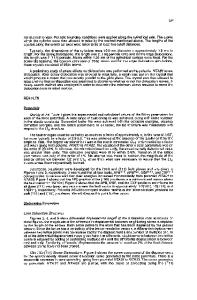Shear faults and dislocation core structures in B2 CoAl
- PDF / 517,091 Bytes
- 12 Pages / 612 x 792 pts (letter) Page_size
- 51 Downloads / 370 Views
MATERIALS RESEARCH
Welcome
Comments
Help
Shear faults and dislocation core structures in B2 CoAl C. Vailh´e and D. Farkas Department of Materials Science and Engineering, Virginia Polytechnic Institute, Blacksburg, Virginia 24061 (Received 14 August 1995; accepted 22 May 1997)
Interatomic potentials of the embedded atom and embedded defect type were derived for the Co–Al system by empirical fitting to the properties of the B2 CoAl phase. The embedded atom potentials reproduced most of the properties needed, except that, in using this method, the elastic constants cannot be fitted exactly because CoAl has a negative Cauchy pressure. In order to overcome this limitation and fit the elastic constants correctly, angular forces were added using the embedded defect technique. The effects of angular forces to the embedded atom potentials were seen in the elastic constants, particularly C44 . Planar fault energies changed up to 30% in the h110j and h112j g surfaces and the vacancy formation energies were also very sensitive to the non-central forces. Dislocation core structures and Peierls stress values were computed for the k100l and k111l dislocations without angular forces. As a general result, the dislocations with a planar core moved for critical stress values below 250 MPa in contrast with the nonplanar cores for which the critical stress values were above 1500 MPa. The easiest dislocations to move were the 1y2k111l edge superpartials, and the overall preferred slip plane was h110j. These results were compared with experimental observations in CoAl and previously simulated dislocations in NiAl.
I. INTRODUCTION
Operating temperatures of engines and their efficiency are now limited by the melting temperature of superalloys and the brittleness of ceramic materials. Among high temperature materials, intermetallics present interesting properties scaled between those of superalloys and ceramics. Although B2 aluminides have good properties for high temperature materials such as high melting points (,1650 ±C), good corrosion resistance and low densities (,5 gycm3 ), the strong ordered bonds that make them durable at high temperature also make them brittle at room temperature. However, intermetallics can be modified to offer limited ductility. This requires a good understanding of the mechanisms of deformation. In the series of B2 aluminides (FeAl, NiAl, CoAl), CoAl presents the most brittle behavior at temperatures below the ductile-brittle transition.1 For this reason, it has been subject to less attention than FeAl or NiAl. Most of the experimental observations in CoAl were conducted in parallel to the studies of NiAl mechanical behavior.1,2 This approach has not been followed by atomistic simulation due to the lack of Co–Al interatomic potentials. Embedded Atom Method (EAM) for molecular statics calculations has been intensively used in NiAl. The method is adequate for the description of the properties of most metallic materials with a positive Cauchy pressure P 1y2(C 12 2 C 44 ). Experimental elastic constants i
Data Loading...











